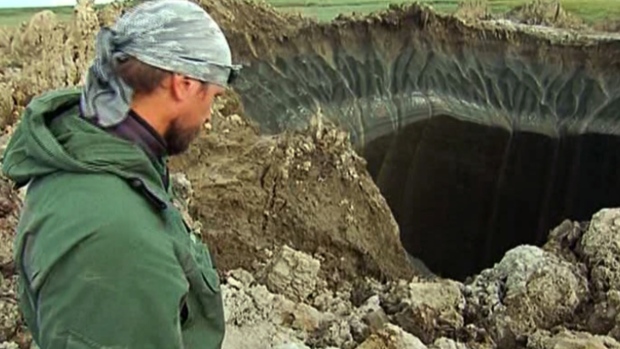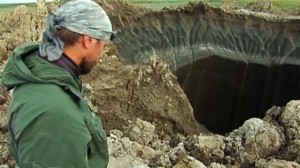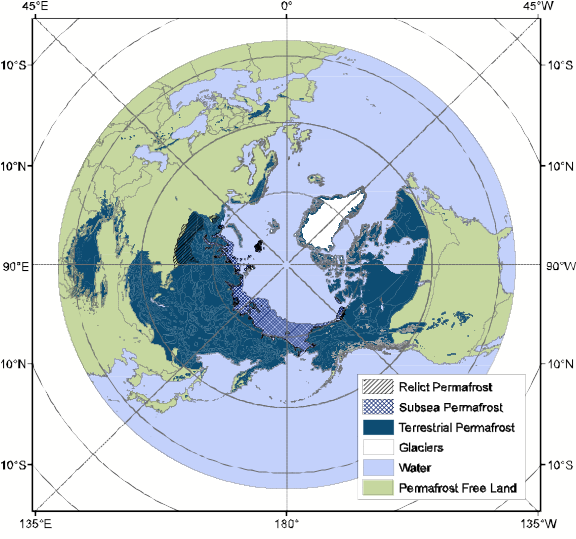August 6, 2014 – The Enola Gay, a B-29 bomber, dropped a uranium-fueled bomb on Hiroshima on this date 69 years ago. The last crew member of that fateful mission, Theodore Van Kirk, recently passed away. He was one of a 12-member crew who in a matter of a few minutes wiped out the lives of more than 100,000 people. Only the Nagasaki bomb dropped three days later offers a comparison with more than 80,000 lives snuffed out.
We humans are good at war and inflicting destruction upon this planet and our species. But what we are not good at is seeing the insidious nature of our technological impact on the climate of our planet. The evidence lies all around us but we choose to ignore it.
The latest, a 30-meter (approximately 100-feet) wide hole opened up in the Yamal Peninsula in Siberia in mid-July (see image above). A second smaller hole nearby has also been reported. Are these sinkholes caused by changes to groundwater levels, or by human activity underground such as mining that could destabilize the ground above? No say those researchers who are studying the phenomenon. Preliminary results indicate that this hole is a methane-created. Melting of permafrost because of abnormally warmer summers over the last two years is to blame. The scientists point to Yamal Peninsula average temperatures over the last two summers averaging 5 Celsius (9 Fahrenheit) warmer. The temperature of permafrost at 20 meters (66 feet) below the surface during this same period has risen by 2 Celsius (3.8 Fahrenheit).
The Yamal Peninsula weather pattern isn’t unique. The polar regions of the Earth, particularly in the Northern Hemisphere, are rapidly warming. In past blog postings here I have described the threat that this warming brings to permafrost area found in abundance across Northern Canada and Russia. Melting is accompanied by sudden changes in the physical landscape (a hole for example). But worse, melting means the release of methane gas, stored in the frozen biomass.
This is a bomb bigger than anything we humans have dropped in a war and it is waiting to go off with implications for global warming that could prove to be more long-term and catastrophic. Methane is 20 times more potent as a greenhouse gas than carbon dioxide. The only saving grace when compared to carbon dioxide is, methane oxidizes within then years so the potency is short term.
Measurements from the crater which is estimated to be 70 meters (230 feet) deep, show levels of methane gas at 9.6%, well above the 0.000179% in the normal atmosphere. The hole continues to change as the rim slowly melts sloughing off water and debris which is filling the base with an estimated 20 meters (70 feet) of water.
The methane in the Yamal Peninsula, in frozen form, is similar to the frozen gas hydrates which Japan last year mined from the ocean floor south of Tokyo. Mining gas hydrate ocean reserves may be viable but the explosive nature of the gas when released makes this a dangerous enterprise at present. But mining gas hydrates from permafrost would be practically impossible and its explosive nature may not be controllable by us with any current or planned technology.
For communities near the hole a sudden release of methane could lead to an explosion, particularly if the gas in sufficient concentration should be in contact with an open fire or exposed electrical wires. If a significant methane release, somewhere between 30 to 85% loss of near-surface permafrost, were to happen in the 24% of the northern hemisphere classified as permafrost (seen in the map below), the methane contained within it, not including the carbon dioxide which is also found in the permafrost biomass, would lead to a global temperature spike between 3 and 6 Celsius (5.4 to 10.8 Fahrenheit) degrees. The melting would impact wetlands and lakes on the surface of the permafrost and alter the habitat for resident life and migratory birds. Human communities built on permafrost would undergo dramatic alterations. Infrastructure such as buildings, roads, and utilities would be badly damaged.











